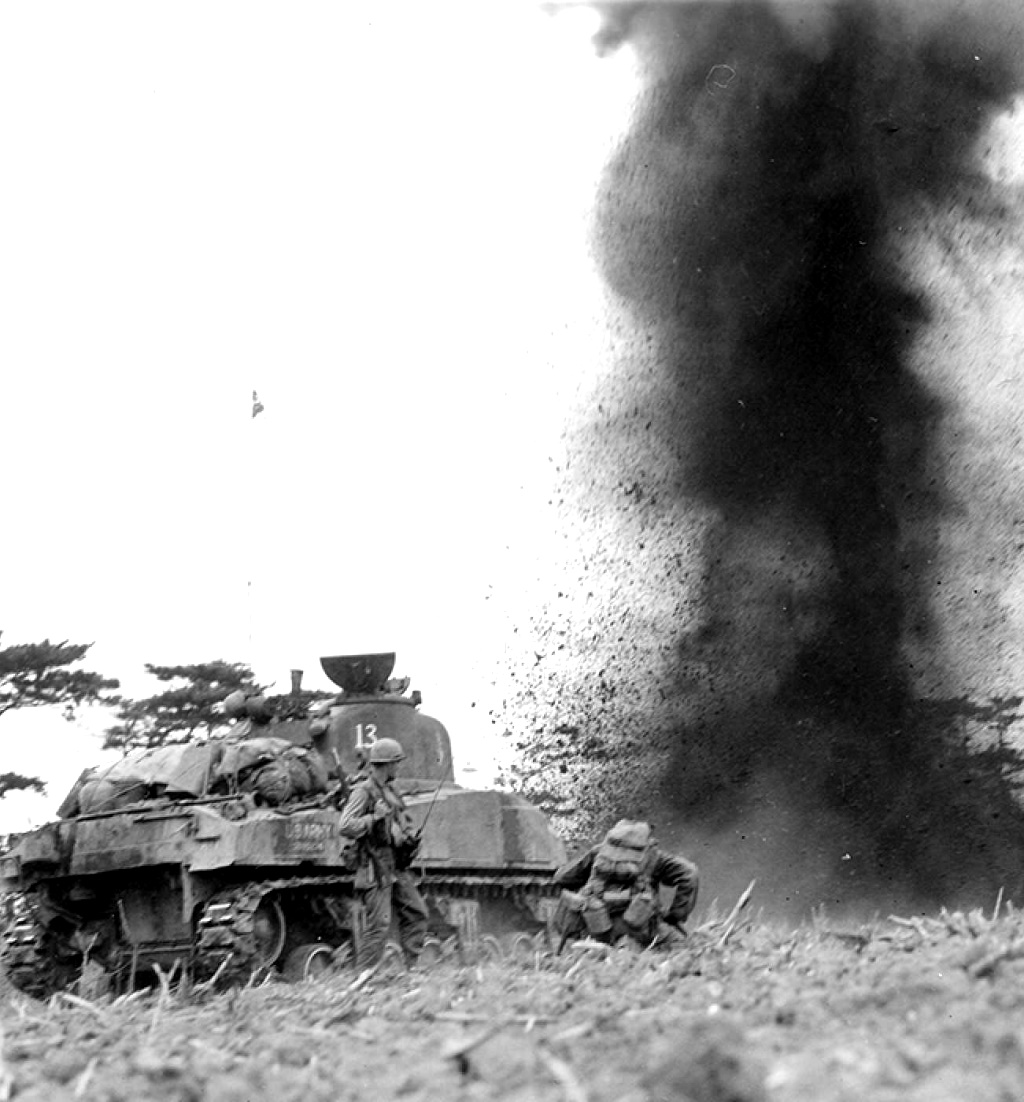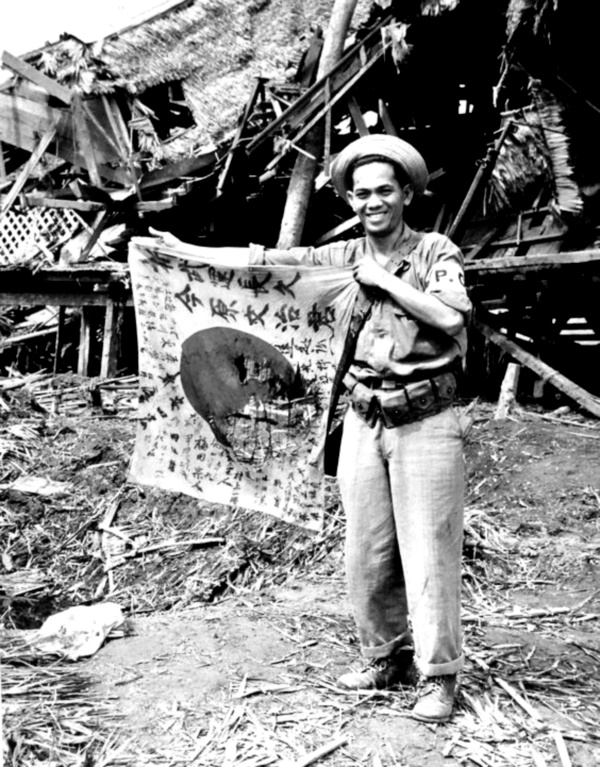Easy Co and Fox Co began to re-organize and prepare for the continuation of the attack. The Battalion supply Officer, Lt Robert J. De Grand, had anticipated the need for ammunition, and carrying parties of the Battalion pioneer and ammunition platoon had delivered the resupply of ammunition to both companies, Easy and Fox. Machine guns and BAR ammunition were the chief requirements at this time. During this reorganization, the Battalion Commander and staff made an estimate of the situation. It was determined that the Japanese outpost had been driven in; the main battle was the next objective. The Battalion objective was the last high ground in the approaches to Ormoc. It was also surmised that the likely a venue or counter-attack for the Japs would be the draw that led up to the objectives and ran deep into the Division head-beach area. The Battalion Commander decided to make a coordinated attack against the Battalion’s next objective with two companies in the assault echelon and to give the reserve company the same flank security mission. It was also felt that a counter-attack would not be made by the Japs until after our troops had jumped off this ridge into the attack against the next objective. The captured objective dominated the Battalion’s right flank. Troops holding that ground easily stop a counter-attack directed into the right flank.
ORDERS AND CONTINUATION OF THE ATTACK
Based on this estimate the Battalion CO ordered Easy Co to continue the attack at 1130. Fox Co, the right flank assault company, was to revert to Battalion Reserve and hold this first objective. It was to be prepared to meet a counter-attack coming down the draw toward the Battalion’s first flank. In addition to flank security, they were to move by bounds and be prepared for employment in the Battalion zone of attack. George Co was ordered to move to the right of Fox Co and attack the next objective in conjunction with Fox Co. George Co was to envelop the Japs left flank and capture the right half of the Battalion objective. The bulk of the Battalion machine guns was to fire from the ridge overlooking the Japs position, and when their fires were marked, were to go into direct support of the front-line companies. Everything possible was done to secure artillery support but to no avail. The terrain to the front now appeared to favor the defender considerably. The area leading to the next objective was an open rice field. There was no cover or concealment. However, it was felt that the Battalion supporting weapons, especially the two machine-gun platoons, could effectively neutralize the Jap position. Thus the order to continue the attack was issued.
Just as the assault companies launched their attack the platoon leader of a chemical mortar platoon (4.2″) reported to the Battalion CO and indicated that he was in direct support of the 2/306. It was too late for this mortar platoon to support the assault echelon. It was therefore given the mission to support Fox Co on the right flank. The mortar platoon immediately planned fire to cover the counter-attack approaches into the area. The progress of the assault companies over the open rice field was much better than expected. There were some casualties but no more than normal for a coordinated attack. At 1226, Easy and George Cos were about to launch their assault. Fox Co at this time reported the Jap troops, approximately one company, concentrating at the head of the draw where the counter-attack was expected. Fox Co and the Chemical Mortar Platoon were ready. As the leading elements of the Jap counter-attack approached the Fox Co positions all planned mortar machine-gun fires were directed at them. The well-planned fires broke up the counter-attack and the Jap forces were fleeing to the north. The effective fire of 4.2″ mortars was the deciding factor.
It soon became apparent why the Japs had held their fire and permitted the Battalion to cross the rice field. The Battalion objective was a hill about 600 by 400 yards and covered with wood. The Japs had the entire area organized with many automatic weapons and cleverly concealed individual riflemen. The area was organized into a number of mutually supporting emplacements and sniper positions. The Japs planned to allow the Battalion to enter the woods and then destroy it. The Battalion did suffer considerable casualties, but small units and individuals stuck to the job of hunting down and killing Japs as they were flushed out of their positions. There were several well-concealed Jap machine guns in the area. Only one or two would fire at any one time. It was very difficult for the men of the Battalion to locate these weapons. Many Jap emplacements were camouflaged so well, that it was often too late when they were discovered.
The Battalion received casualties much greater in number than those inflicted on the Japs. It was now 1645. Normally the Battalion would cease all action at 1600 and prepare perimeter defense for the night. It usually took about two hours to complete a well-organized perimeter defense, and tie it in with the adjacent units. During this critical period, the Battalion Commander was moving back and forth between the two front-line companies. His presence during this critical phase paid dividends. He was able to see the situation confronting the Battalion and to make proper coordination with units on the flank.
Just prior to dark, the Battalion CO received word that the 305-IR had been ordered to move up to the Battalion’s right flank and then extend back around the new beachhead. Lt Col Cavness coordinated this flank and gave the Battalion CO of the 305-IR the situation in that area. Easy Co, commanded by Capt Bringham, fought hard and aggressively throughout the entire day. They overran the objective and were within 300 yards of Camp Downs, at nightfall. Easy Co had come beyond the line held by 3/307 on the left. The Battalion had just tied in its flanks. The Battalion situation was presented to the Regimental CO. A request was made to delay the continuation of the attack on the next day to allow reorganization and resupply. The Regimental CO accordingly decided to attack with a fresh Battalion due to the heavy casualties.
During the late afternoon and all throughout the night Capt Summer Davis, the Battalion Surgeon evacuated about 165 of the wounded. There were about 30 dead. Most of these casualties fell during the bitter fighting for the Battalion objective which was named Bloody Hill by the men. During the heavy fighting late in the afternoon, Capt Davis moved his aid station close to the assault Companies. This location was in the range of small arms fire, but due to the nature of the fighting, it was felt that the aid station could receive the casualties and evacuate quicker. Additional aid was requested from higher headquarters which promptly furnished a Mobile Surgical Hospital. This Hospital consisted of three surgeons and the necessary facilities to battlefield surgery.
PREPARATIONS FOR THE NIGHT
The Division SOP did not permit activity at night. The perimeter-type defense was to be organized and anyone moving in the front line would be shot. The night watch was organized by making two and three men groups. Members of the groups would each observe for Japs infiltrating tactics. The Japs were well-trained in this role. As night fell the Battalion CO knew the flank situation, but very little about the actual situation and combat efficiency of the two front-line companies. There was no radio communication with them. Either their radio operations had become casualties or they had closed their ton fearing ambush by the Japs. It was quite important that the front-line companies render a report, but none arrived. The Battalion could not continue the attack without a reorganization the next morning. A staff officer was dispatched to each of the front-line companies. They could not return that night. The next morning they reported that, although the objective was completely taken, the platoons were not under the control of the Company Commanders.
The next morning the Battalion was assembled and it reverted to Division Reserve. Chaplain Mallory, Battalion Chaplain, as was his custom supervised the collection of the Battalion’s dead and escorted them to the Division cemetery. Here he conducted their burial ceremony. The manner in which Chaplain Mallory handled the dead contributed greatly to the morale of the troops. To summarize the 2/306-IR, being attached to the 307-IR and without artillery support reduced two well-organized objectives utilizing its own support weapons to the maximum extent. Although it was a well-coordinated and aggressively conduct attack the final stand by well-camouflaged Japs made the ground attack the ground gained very costly. The swift action of the Battalion, in penetrating the Japs mainline did contribute greatly to the final capture of the Division objective.






















